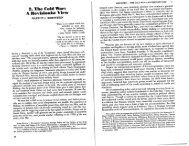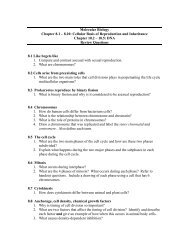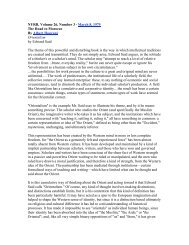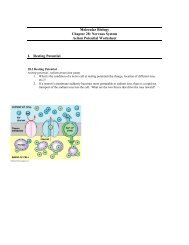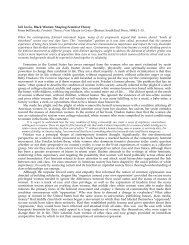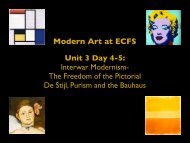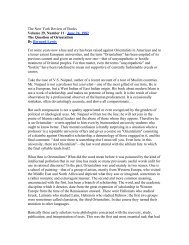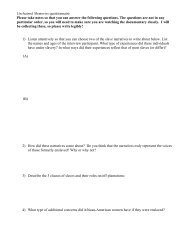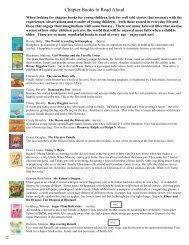and culture, to ensnare ordinary people in a giant web ofnationhood pretending to a common interest. I will try notto overlook the cruelties that victims inflict on one anotheras they are jammed together in the boxcars of the system. Idon’t want to romanticize them. But I do remember (in roughparaphrase) a statement I once read: “The cry of the poor is notalways just, but if you don’t listen to it, you will never knowwhat justice is.”I don’t want to invent victories for people’s movements. Butto think that history-writing must aim simply to recapitulatethe failures that dominate the past is to make historianscollaborators in an endless cycle of defeat. If history is tobe creative, to anticipate a possible future without denyingthe past, it should, I believe, emphasize new possibilities bydisclosing those hidden episodes of the past when, even ifin brief flashes, people showed their ability to resist, to jointogether, occasionally to win. I am supposing, or perhaps onlyhoping, that our future may be found in the past’s fugitivemoments of compassion rather than in its solid centuries ofwarfare.That, being as blunt as I can, is my approach to the history ofthe United States. The <strong>reader</strong> may as well know that beforegoing on what Columbus did to the Arawaks of the Bahamas,Cortes did to the Aztecs of Mexico, Pizarro to the Incas ofPeru, and the English settlers of Virginia and Massachusettsto the Powhatans and the Pequots.The Aztec civilization of Mexico came out of the heritageof Mayan, Zapotec, and Toltec cultures. It built enormousconstructions from stone tools and human labor, developeda writing system and a priesthood. It also engaged in (let usnot overlook this) the ritual killing of thousands of people assacrifices to the gods. The cruelty of the Aztecs, however, didnot erase a certain innocence, and when a Spanish armadaappeared at Vera Cruz, and a bearded white man came ashore,with strange beasts (horses), clad in iron, it was thoughtthat he was the legendary Aztec man-god who had diedthree hundred years before, with the promise to return—themysterious Quetzalcoatl. And so they welcomed him, withmunificent hospitality.That was Hernando Cortes, come from Spain with anexpedition financed by merchants and landowners and blessedby the deputies of God, with one obsessive goal: to find gold.In the mind of Montezuma, the king of the Aztecs, there musthave been a certain doubt about whether Cortes was indeedQuetzalcoatl, because he sent a hundred runners to Cortes,bearing enormous treasures, gold and silver wrought Intoobjects of fantastic beauty, but at the same time begging himto go back. (The painter Dürer a few years later described whathe saw just arrived in Spain from that expedition—a sun ofgold, a moon of silver, worth a fortune.)Cortes then began his march of death from town to town,using deception, turning Aztec against Aztec, killing withthe kind of deliberateness that accompanies a strategy—toparalyze the will of the population by a sudden frightful deed.And so, in Cholulu, he invited the headmen of the Cholulanation to the square. And when they came, with thousandsof unarmed retainers, Cortes’s small army of Spaniards,posted around the square with cannon, armed with crossbows,mounted on horses, massacred them, down to the last man.Then they looted the city and moved on. When their cavalcadeof murder was over they were in Mexico City, Montezuma wasdead, and the Aztec civilization, shattered, was in the handsof the Spaniards.All this is told in the Spaniards’ own accounts.In Peru, that other Spanish conquistador Pizarro, used thesame tactics, and for the same reason--the frenzy in the earlycapitalist states of Europe for gold, for slaves, for productsof the soil, to pay the bondholders and stockholders of theexpeditions, to finance the monarchical bureaucracies risingin Western Europe, to spur the growth of the new moneyeconomy rising out of feudalism, to participate in what KarlMarx would later call “the primitive accumulation of capital.”These were the violent beginnings of an intricate system oftechnology, business, politics, and culture that would dominatethe world for the next five centuries.In the North American English colonies, the pattern was setearly, as Columbus had set it in the islands of the Bahamas.In 1585, before there was any permanent English settlementin Virginia, Richard Grenville landed there with seven ships.The Indians he met were hospitable, but when one of themstole a small silver cup, Grenville sacked and burned the wholeIndian village.Jamestown itself was set up inside the territory of an Indianconfederacy, led by the chief, Powhatan. Powhatan watchedthe English settle on his people’s land, but did not attack,maintaining a posture of coolness. When the English weregoing through their “starving time” in the winter of 1610, someof them ran off to join the Indians, where they would at least befed. When the summer came, the governor of the colony sent amessenger to ask Powhatan to return the runaways, whereuponPowhatan, according to the English account, replied with “noeother than prowde and disslaynefull Answers.” Some soldierswere therefore sent out “to take Revendge.” They fell upon anIndian settlement, killed fifteen or sixteen Indians, burned thehouses, cut down the corn growing around the village, tookthe queen of the tribe and her children into boats, then endedup throwing the children overboard “and shoteinge owtt theirBraynes in the water.” The queen was latertaken off and stabbed to death.Twelve years later, the Indians, alarmed as the Englishsettlements kept growing in numbers, apparently decided totry to wipe them out for good. They went on a rampage andmassacred 347 men, women, and children. From then on itwas total war.Not able to enslave the Indians, and not able to live with them,the English decided to exterminate them. Edmund Morgan83
writes, in his history of early Virginia, American Slavery,American Freedom:Since the Indians were better woodsmen than the English andvirtually impossible to track down, the method was to feignpeaceful intentions, let them settle down and plant their cornwherever they chose, and then, just before harvest, <strong>fall</strong> uponthem, killing as many as possible and burning the corn.... .Within two or three years of the massacre the English hadavenged the deaths of that day many times over.In that first year of the white man in Virginia, 1607, Powhatanhad addressed a plea to John Smith that turned out prophetic.How authentic it is may be in doubt, but it is so much likeso many Indian statements that it may be taken as, if not therough letter of that first plea, the exact spirit of it:I have seen two generations of my people die.. . .I know the differencebetween peace and war better than any man in my country. I amnow grown old, and must die soon; my authority must descend tomy brothers, Opitchapan, Opechancanough and Catatough—thento my two sisters, and then to my two daughters. I wish them toknow as much as I do, and that your love to them may be like mineto you. Why will you take by force what you may have quietly bylove? Why will you destroy us who supply you with food? What canyou get by war? We can hide our provisions and run into the woods;then you will starve for wronging your friends. Why are you jealousof us? We are unarmed, and willing to give you what you ask, if youcome in a friendly manner, and not so simple as not to know that itis much better to eat good meat, sleep comfortably, live quietly withmy wives and children, laugh and be merry with the English, andtrade for their copper and hatchets, than to run away from them,and to lie cold in the woods, feed on acorns, roots and such trash, andbe so hunted that I can neither eat nor sleep. In these wars, my menmust sit up watching, and if a twig break, they all cry out “Herecomes Captain Smith!” So I must end my miserable life. Take awayyour guns and swords, the cause of all our jealousy, or you may alldie in the same manner.When the Pilgrims came to New England they too werecoming not to vacant land but to territory inhabited by tribesof Indians. The governor of the Massachusetts Bay Colony,John Winthrop, created the excuse to take Indian land bydeclaring the area legally a “vacuum.” The Indians, he said, hadnot “subdued” the land, and therefore had a “natural” right toit, but not a “civil right.” A “natural right” did not have legalstanding.The Puritans also appealed the Bible, Psalms 2:8: “Ask of me,and I shall give thee, the heathen for thine inheritance, andthe uttermost parts of the earth for thy possession.” And tojustify their use of force to take the land, they cited Romans13:2: “Whosoever therefore resisteth the power, resisteththe ordinance of God: and they that resist shall receive tothemselves damnation.”The Puritans lived in uneasy truce with the Pequot Indians,who occupied what is now southern Connecticut and RhodeIsland. But they wanted them out of the way; they wantedtheir land. And they seemed to want also to establish theirrule firmly over Connecticut settlers in that area. The murderof a white trader, Indian-kidnapper, and troublemaker becamean excuse to make war on the Pequots in1636.A punitive expedition left Boston to attack the NarragansettIndians on Block Island, who were lumped with the Pequots.As Governor Winthrop Wrote:They had Commission to put to death the men of Block Island,but to spare the women and children, and to bring them away,and to take possession of the island; and from thence to goto the Pequods to demand the murderer of Captain Stoneand other English, and one thousand fathom of wampom fordamages, etc and some of their children as hostages, which ifthey should refuse, they were to Obtain by force.The English landed and killed some Indians, but the rest hidin the thick forests of the island and the English went fromone deserted village to the next, destroying crops. Then theysailed back to the mainland and raided Pequot villages alongthe coast, destroying crops again. One of the officers of thatexpedition, in his account, gives some insight into the Pequotsthey encountered: “The Indians spying of us came running inmultitudes along the water side, crying, What cheer, Englishmen,what cheer, what do you come for? They not thinking weintended war, went on cheerfully. . .”So, the war with the Pequots began. Massacres took placeon both sides. The English developed a tactic of warfare usedearlier by Cortes and later, in the twentieth century, even moresystematically: deliberate attacks on noncombatants for thepurpose of terrorizing the enemy. This is ethnohistorian FrancisJennings’s interpretation of Captain John Mason’s attack on aPequot village on the Mystic River near Long Island Sound:“Mason proposed to avoid attacking Pequot warriors, whichwould have overtaxed his unseasoned, unreliable troops. Battle,as such, was not his purpose. Battle is only one of the waysto destroy an enemy’s will to fight. Massacre can accomplishthe same end with less risk, and Mason had determined thatmassacre would be his objective.”So the English set fire to the wigwams of the village. By theirown account: “The Captain also said, We must Burn Them;and immediately stepping into the Wigwam . . . brought out a84 <strong>fieldston</strong> <strong>american</strong> <strong>reader</strong> <strong>volume</strong> i – <strong>fall</strong> <strong>2007</strong>
- Page 4 and 5:
the federalist papers #51 (1787)...
- Page 6 and 7:
Inventing An AmericaCrèvecoeur Dis
- Page 8 and 9:
I say to you today, my friends, tha
- Page 10 and 11:
melodies of the Negro slave; the Am
- Page 12 and 13:
31.the encounterand north americasu
- Page 14 and 15:
Native American PoetryWHEN SUN CAME
- Page 16 and 17:
Pagans and Pilgrims in the Promised
- Page 18 and 19:
Reverend Doctor Sepulveda has spoke
- Page 20 and 21:
Juan Gines de Sepulveda:“The Grea
- Page 22 and 23:
Nathaniel Bacon: Bacon’s Declarat
- Page 24 and 25:
The sale of human beings in the mar
- Page 26 and 27:
seeking great things for ourselves
- Page 28 and 29:
Therefore, let every one that is ou
- Page 30 and 31:
frontier village she revised her ea
- Page 32 and 33:
Edward Taylor: Poems (1642—I729)L
- Page 34 and 35: The Mayflower CompactNovember 11, 1
- Page 36 and 37: fly kites and shoot marbles, and to
- Page 38 and 39: Dominie Van Shaick, the village par
- Page 40 and 41: another man. In the midst of his be
- Page 42 and 43: Washington Irving:The Legend of Sle
- Page 44 and 45: a kind of idle gentlemanlike person
- Page 46 and 47: Tassel. In this enterprise, however
- Page 48 and 49: on the top of his nose, for so his
- Page 50 and 51: however, turned upon the favorite s
- Page 52 and 53: the green knoll on which stands the
- Page 54 and 55: so any nation, that discovers an un
- Page 56 and 57: indefatigable measures, the cause o
- Page 58 and 59: their heads on their shoulders inst
- Page 60 and 61: Metacomet Cries Out for RevengeIn t
- Page 62 and 63: Gustavus Vassa: The Interesting Nar
- Page 64 and 65: duct, and guard them from evil. The
- Page 66 and 67: particularly at full moons; general
- Page 68 and 69: that might come upon us; for they s
- Page 70 and 71: size of the finger nail. I was sold
- Page 72 and 73: intolerably loathsome, that it was
- Page 74 and 75: as he instinctively guessed its app
- Page 76 and 77: Document DSource: Articles of Agree
- Page 78 and 79: Next to manners are the exterior gr
- Page 80 and 81: Howard Zinn: Columbus, the Indians,
- Page 82 and 83: same token covet the possessions of
- Page 86 and 87: Fire Brand, and putting it into the
- Page 88 and 89: included the Mohawks (People Of the
- Page 90 and 91: It has been tempting to dismiss Jef
- Page 92 and 93: she found herself back in prison. M
- Page 94 and 95: 311.the struggle forindependence176
- Page 96 and 97: John Locke: of Civil Government (16
- Page 98 and 99: Daniel Dulany: “Considerations”
- Page 100 and 101: First Continental Congress, Declara
- Page 102 and 103: colonies enabled her to triumph ove
- Page 104 and 105: and America is a strong and natural
- Page 106 and 107: considerable pecuniary resources, b
- Page 108 and 109: He has combined with others to subj
- Page 110 and 111: Mary Beth Norton:Women in the Revol
- Page 112 and 113: testified, so “I was obliged to S
- Page 114 and 115: peace terms. And, tragically, Samue
- Page 116 and 117: not that this glorious threesome ne
- Page 118 and 119: less powerful than the rest, as it
- Page 120 and 121: paramount culture, but to many for
- Page 122 and 123: James Kirby Martin: Protest and Def
- Page 124 and 125: 3111.developing a frameworkfor gove
- Page 126 and 127: The Articles of Confederation (1777
- Page 128 and 129: 7. Whenever the Confederate Lords s
- Page 130 and 131: Darkness there, and nothing more.De
- Page 132 and 133: Edgar Allen Poe:The Fall of the Hou
- Page 134 and 135:
of unnatural sensations. Some of th
- Page 136 and 137:
the full extent, or the earnest aba
- Page 138 and 139:
paused; for it appeared to me (alth
- Page 140 and 141:
Walt Whitman:Poetry Crossing Brookl
- Page 142 and 143:
101 Flow on, river! flow with the f
- Page 144 and 145:
41 Nor any more youth or age than t
- Page 146 and 147:
136 I am not an earth nor an adjunc
- Page 148 and 149:
13225 The negro holds firmly the re
- Page 150 and 151:
322 Patriarchs sit at supper with s
- Page 152 and 153:
415 And if each and all be aware I
- Page 154 and 155:
511 Voices of cycles of preparation
- Page 156 and 157:
27611 To be in any form, what is th
- Page 158 and 159:
702 Head high in the forehead, wide
- Page 160 and 161:
806 I go hunting polar furs and the
- Page 162 and 163:
908 Ten o’clock at night, the ful
- Page 164 and 165:
1001 I do not ask who you are, that
- Page 166 and 167:
1099 Believing I shall come again u
- Page 168 and 169:
1200 The great Camerado, the lover
- Page 170 and 171:
1294 And as to you Corpse I think y
- Page 172 and 173:
James Madison:The Federalist Papers
- Page 174 and 175:
James Madison:The Federalist Papers
- Page 176 and 177:
people are impliedly and incidental
- Page 178 and 179:
sort of people, who are orderly and
- Page 180 and 181:
Charles Beard: The ConstitutionA Mi
- Page 182 and 183:
Legislatures reflect these interest
- Page 184 and 185:
Staughton Lynd:The Conflict Over Sl
- Page 186 and 187:
France is an example. Jefferson had
- Page 188 and 189:
to the interior & landed interest,
- Page 190 and 191:
The first was to solve the problem
- Page 192 and 193:
there against mobs, demagogues, and
- Page 194 and 195:
3iv.the early republic: forging ana
- Page 196 and 197:
Alexander Hamilton and Thomas Jeffe
- Page 198 and 199:
employment to industrious individua
- Page 200 and 201:
Hamiltonian Federalists and Jeffers
- Page 202 and 203:
“As the present crisis of human a
- Page 204 and 205:
The Kentucky Resolutions of 1799The
- Page 206 and 207:
Washington’s Farewell Address,Sep
- Page 208 and 209:
equal law must protect, and to viol
- Page 210 and 211:
I sec.8, Congress has also been gra
- Page 212 and 213:
That the following amendments of th
- Page 214 and 215:
3v.the disgusting spirit ofequality
- Page 216 and 217:
Transcendentalism DefinedThough clo
- Page 218 and 219:
All are needed by each one;Nothing
- Page 220 and 221:
a long period continue, to rule is
- Page 222 and 223:
The broadest and most prevalent err
- Page 224 and 225:
clergyman whose preaching my father
- Page 226 and 227:
difference between resisting this a
- Page 228 and 229:
similar concern for the conditions
- Page 230 and 231:
few years I have been gravely disap
- Page 232 and 233:
In the midst of blatant injustices
- Page 234 and 235:
about the baby, whom she had hardly
- Page 236 and 237:
who, with conjugal affections and m
- Page 238 and 239:
a hut, tranquil, if in a crowd. The
- Page 240 and 241:
South Carolina Ordinance of Nullifi
- Page 242 and 243:
operation....The right to secede is
- Page 244 and 245:
Worcester v. Georgia and refused to
- Page 246 and 247:
effect in point of possession when
- Page 248 and 249:
hold the writer maintained with the
- Page 250 and 251:
986A narrow Fellow in the GrassOcca
- Page 252 and 253:
house.“You done talk too much wid
- Page 254 and 255:
Kate Chopin: The StormIThe leaves w
- Page 256 and 257:
IVAlcée Laballière wrote to his w
- Page 258 and 259:
When the letter reached Desiree she
- Page 260 and 261:
Her lip was beginning to tremble, a
- Page 262 and 263:
IIITheir eyes met, and she blushed
- Page 264 and 265:
een reversed.“Why, how do you do?
- Page 266 and 267:
of a juggler tossing knives; but th
- Page 268 and 269:
Having deprived her of this first r
- Page 270 and 271:
Sojorner Truth: Ain’t I A Woman?S
- Page 272 and 273:
Viewpoints of the Mexican WarThe fo
- Page 274 and 275:
evolt and sin...”Caleb Atwater, E
- Page 276 and 277:
encouraged this ideal of the perfec
- Page 278 and 279:
its own territory, with boundaries
- Page 280 and 281:
3vi.slavery, sectionalismand secess
- Page 282 and 283:
Charles W. Chestnut:The Passing of
- Page 284 and 285:
promptness and decision. “He’s
- Page 286 and 287:
left the hotel when a long‐haired
- Page 288 and 289:
and sent to the penitentiary. I tho
- Page 290 and 291:
Necessary Evil to Positive GoodSour
- Page 292 and 293:
Dred Scott vs Sanford (1857)The fol
- Page 294 and 295:
The Lincoln-Douglas Debates (1858)I
- Page 296 and 297:
DBQ: Free Soil, Free Labor, Free Me
- Page 298 and 299:
of the slave-holding system is to d
- Page 300 and 301:
“Why, not a cruel man, exactly, b
- Page 302 and 303:
Lincoln Denies Racial EqualityInter
- Page 304 and 305:
through an unseen multitude.“Ther
- Page 306 and 307:
that they intercepted, even for a m
- Page 308 and 309:
earded elders of the church have wh
- Page 310 and 311:
speak of. What! I have authority, I
- Page 312 and 313:
nothing to be shunned in the handso
- Page 314 and 315:
summer sun, it was his father’s c
- Page 316 and 317:
a human form appeared at intervals,



